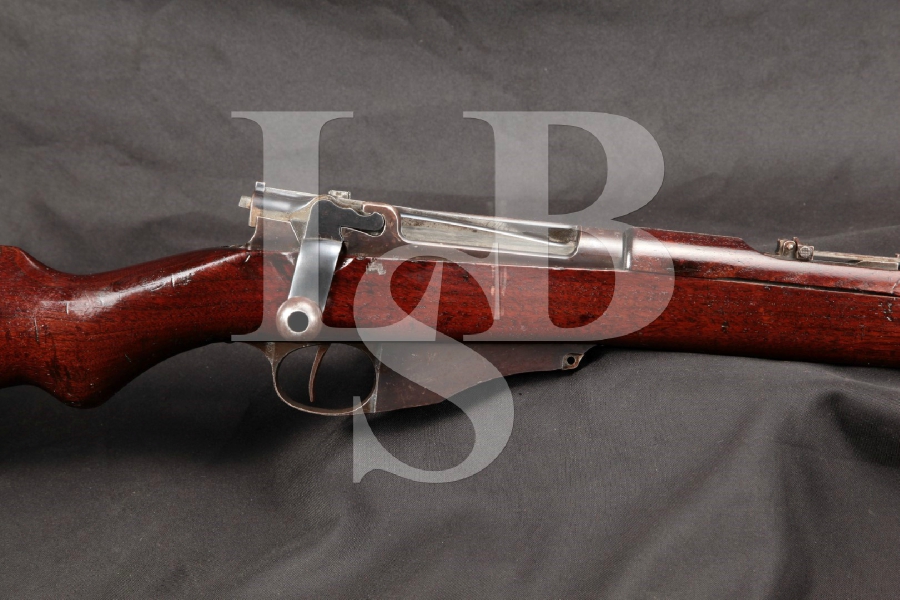
Winchester Model 1895 (M1895) Lee Navy 28” Straight Pull Bolt Action Rifle, MFD 1896 Antique
SOLD FOR: $1,956.00
LSB#: 150820JS02
Make: Winchester Repeating Arms
Model: Model 1895 Lee Navy
Serial Number: 1761
Year of Manufacture: 1896
Caliber: 6mm Lee Navy (6x60mmSR)
Action Type: Straight Pull Bolt Action, Fixed Magazine
Markings: The left side of the receiver is marked “MANUFACTURED BY THE WINCHESTER REPEATING ARMS CO / NEW HAVEN. CONN. U.S.A. PAT. OCT.10.93 JAN.30.94 OCT.8.95”. The top of the receiver is marked “-U.S.N.- / anchor / No. 1761 / -N.C.T.- (inspector’s initials)“. The left side of the barrel band and the left side of the sight hood are both marked “U”.
Barrel Length: Approximately 28 Inches
Sights / Optics: The front sight is a bladed post set under a protective hood. The rear sight is a sliding “U” notched blade assembly. When down it is a sliding elevator marked “3” and “5” on the left side of the sight base. When flipped up it becomes a sight ladder marked from “8 – 20”.
Stock Configuration & Condition: The stock has a pistol grip, two barrel bands, a stacking loop, two sling loops and a metal buttplate with a sliding door for storage. The top rear of the handguard is cracked and the front is missing a piece of edge wood. The stock shows other scrapes, scratches and compression marks. A few are deep and have removed surface wood. The LOP measures 14 1/8 inches from the front of the trigger to the back of the buttplate. The stock rates in about Fine overall condition, for its age.
Type of Finish: Blue
Finish Originality: Original
Bore Condition: The grooves are dark and the rifling is deep. There is frosting at the bore.
Overall Condition: The barrel shows discoloration from oxidation, scrapes and a few small scratches. The receiver and magazine shows some thinning, some scrapes, areas of surface erosion and frosting. The sight hood and buttplate show areas of pitting. The screws show use. The markings are deep. Overall, this rifle rates in about Fine condition, for its age.
Mechanics: The action functions correctly. We have not fired this rifle. As with all previously owned firearms, a thorough cleaning may be necessary to meet your maintenance standards.
Box, Paperwork & Accessories: None
Our Assessment: This Model 1895 Lee Navy Rifle was made back in 1896 by Winchester Repeating Arms. It is one of about 15,000 M1885 rifles that were made. Many of these rifles saw combat and it is rare to see one in this Fine of condition. Here is some M1885 military history from Wikipedia: The M1895 Lee was carried aboard Navy ships for use by naval armed guards (blue jackets) and landing parties, and was the standard service rifle for enlisted Marines, both seaborne and guard forces. Fifty-four USN Lee rifles were recovered from the Battleship Maine, which was sunk in Havana harbor in 1898. These were eventually sold to Bannerman’s, a military surplus dealer. Surviving examples seen of the confirmed Maine rifles have pitted receivers, which would be logical considering the salt water immersion in Havana Harbor. After the outbreak of the Spanish-American War, the M1895 was issued to marines of the First Marine Battalion aboard the naval transport USS Panther, commanded by Lieutenant-Colonel Robert W. Huntington. As far as is known, all Marine companies involved in the Cuba combat operations were equipped with the 6mm Lee rifle. In addition to service with the First Battalion, additional rifles were later distributed by navy quartermasters to elements of free Cuban forces revolting against the Spanish government…The first major combat use of the M1895 occurred during the land campaign to capture Guantánamo Bay, Cuba from June 9–14, 1898 with the First Marine Battalion, in particular at the battles of Camp McCalla and Cuzco Wells. During the battle of Cuzco Wells, Marines using the M1895 Lee effectively engaged concentrations of Spanish troops at ranges up to 1,200 yards, using volley fire against groups of enemy soldiers while their officers called out the range settings…The M1895 would see considerable action in the Pacific during the Spanish-American War and the early stages of the later Philippine–American War with U.S. Navy and Marine personnel.”

